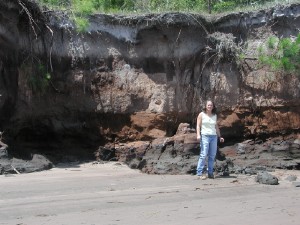Solvent Plume Source Removal Test (Fenton's Reagent)
| Type |
- Testing of Remediation Technologies
- Performance Monitoring
|
| Location |
Naval Submarine Base Kings Bay, Georgia |
| Partners |
|
| Technology |
|
| Contaminants |
Perchloroethylene (PCE) |
| Description |
 Concentrations of vinyl chloride in the Kings Bay, Georgia, plume, November 1998. Vinyl chloride is a very toxic byproduct of the incomplete degradation of perchloroethylene (from USGS Circular 1303)
Concentrations of vinyl chloride in the Kings Bay, Georgia, plume, November 1998. Vinyl chloride is a very toxic byproduct of the incomplete degradation of perchloroethylene (from USGS Circular 1303)
(Click on image for larger version) |
|
Remediation of a plume of perchloroethylene (PCE) at Naval Submarine Base Kings Bay, Georgia, has been achieved by
combining source-area removal and natural attenuation. PCE in the
source area, an old landfill, was removed by in-situ chemical oxidation with Fenton's reagent. Fenton's reagent was injected into the subsurface
through an array of injection wells. USGS scientists estimate that the plume will diminish to below regulatory
thresholds in less than 5 years. This technology has reduced the time to remediate the site from 35 years (with the
previous pump-and-treat system) to approximately 5 years. This, in turn, has lowered lifetime remediation costs at
the site from $30 million to approximately $5 million.
USGS involvement with the Fenton's injection test at Kings Bay was to:
- locate the source area with direct-push technology and field gas chromatography methods,
- determine the source-area contaminant concentration that could remain after the Fenton's test, based on the
natural attenuation capacity of the system, and
- monitor the microbial population at the site before, during, and after Fenton's treatment to observe how
contaminant degradation was affected by the treatment.
Water-quality monitoring data from the landfill site are being used to evaluate the ability of the
Natural Attenuation Software (NAS) package to estimate cleanup times associated
with combining the remediation of a contaminant source-area with using Monitored Natural Attenuation (MNA) to
remediate the remaining downgradient contaminant plume. This site is one of eight demonstration sites that make up a
diverse set of geologic, hydraulic, and geochemical environments. The evaluation is being conducted by the U.S. Navy,
Virginia Polytechnic Institute and State University (Virginia Tech), and U.S. Geological Survey (USGS), with funding
from the Environmental Security Technology Certification Program (ESTCP).
 USGS scientist examining an outcrop of organic-rich sediment that drives sustainable natural attenuation of a chlorinated-solvents plume in the ground-water system underlying Kings Bay, GA
USGS scientist examining an outcrop of organic-rich sediment that drives sustainable natural attenuation of a chlorinated-solvents plume in the ground-water system underlying Kings Bay, GA
(Click on image for larger version) |
|
This site was also featured as a case study in A framework for assessing the sustainability of monitored natural attenuation: U.S. Geological Survey Circular 1303. The framework presents methods to assess the sustainability of natural attenuation at toxic waste cleanup sites, such as the Kings Bay site. The framework provides environmental planners and managers with a quantitative framework for insuring the sustainability of natural attenuation when it is used as a component of waste management strategies. |
| More Information |
|
| Contact |
Frank Chapelle, South Carolina District, Columbia, SC,
|
| Publications |
Chapelle, Frank, Bradley, Paul, and Casey, Clifton, 2004, Accelerated cleanup follows Fenton's ISCO
and substrate addition: Technology News and Trends, EPA Technology Innovation Program online newsletter, December
2004. Chapelle, F.H., and Bradley, P.M., 1998, Selecting remediation goals by assessing the natural attenuation
capacity of ground-water systems: Bioremediation Journal, v. 2, no. 3-4, p. 227-238.
Chapelle, F.H., and Bradley, P.M., 1999, Selecting remediation goals by assessing the natural
attenuation capacity of ground-water systems, in Morganwalp, D.W., and Buxton, H.T., eds., U.S. Geological Survey
Toxic Substances Hydrology Program--Proceedings of the Technical Meeting, Charleston, South Carolina, March 8-12,
1999--Volume 3 of 3--Subsurface Contamination from Point Sources: U.S. Geological Survey Water-Resources
Investigations Report 99-4018C, p. 7-19.
Chapelle, F.H., Novak, J.T., Parker, J.C., Campbell, B.G., and Widdowson, M.A., 2007, A framework for assessing the sustainability of monitored natural attenuation: U.S. Geological Survey Circular 1303, 46 p.
|
| Links |
Other Toxics Program In-Situ Chemical Oxidation Projects
Other USGS In-Situ Chemical Oxidation Projects
Toxics Program Landfill Remediation Projects
Other USGS Landfill Remediation Studies
- Area 6 Landfill, Naval Air Station Whidbey Island, Island County, Washington
- Surface Geophysical
Investigation of a Chemical Waste Landfill in Northwestern Arkansas
- Operable Unit 1 (Landfill), Naval Undersea Warfare Center, Division Keyport, Washington
- Identification of Potential Water-Bearing Zones by
the Use of Borehole Geophysics in the Vicinity of Keystone Sanitation Superfund Site, Adams County, Pennsylvania, and
Carroll County, Maryland: USGS WRIR 97-4104 (pdf)
Natural Attenuation Software (NAS) Information
|
Back to previous page
Back to Toxics Program Remediation Activities Index
|

|